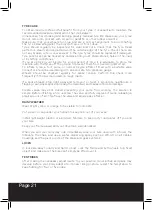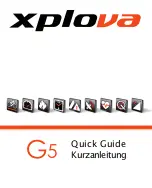
Page 19
GENERAL MAINTENANCE
WARNING: As with all mechanical components, the bicycle is subjected to wear and high
stresses. Different materials and components may react to wear or stress fatique in
different ways. If the design life of a component has been exceeded, it may suddenly
fail possibly causing injuries to the rider. Any form of crack, scratched or change of
colouring in highly stressed areas indicate that the life of the components has been
reached and it should be replaced. We recommend that only genuine replacement parts
are used for safety critical components.
CHAIN MAINTENANCE
When you hear the disconcerting scrunch of “chain sucking” and it feels as if a stick has
been jammed through your chainrings, stop pedalling immediately. Get off and turn the
crank backward to free the chain. Otherwise, you risk damage to the chain, chainring,
and chainstay.
Extreme chain angles , such as combining the largest rear cog with the large chainring
(or smallest cog with the small chainring), may never run quietly or smoothly, which is
one reason they shouldn’t be used. Another reason not to use these gear combinations:
It could cause additional wear on your drivetrain.
If possible, lube your chain 24 hours before riding. This will allow the lube’s liquid carrier
to evaporate and keep your drivetrain cleaner. We recommend to lube the chain after
every 4th ride.
Hose your bike after riding in the rain to remove most of the grit. Then dry it with a
towel, and spray lubrication into derailleur and brake pivot points and where cables
enter or exit their housings.
The most important rule of mountain bike maintenance is frequent cleaning. Dirt
acts as a grinding compound when it gets between moving parts. In muddy or sandy
conditions, hose down the bike after every ride.
WHEELS AND TYRES
Carry a patch kit and a spare tube, so you’re not hopelessly stranded if you have two
flats on a ride. Also, carry a spare tube in the rain. Flats occur more frequently, and it’s
difficult to apply patches when it’s wet.
The patches in most tire repair kits have foil on one side and plastic on the other. the
surface under the foil goes against the tube( after glue has been applied) and then the
plastic is peeled off.
When a tire is properly installed, its bead (the thin line molded into the rubber just above
the rim) should not bob when the wheel spins. However, if the line between the tyre’s
side wall and black tread wobbles, don’t worry-most tires have some irregularity and it
won’t affect performance.
At least once a month, inspect each tyre’s tread for embedded glass or other debris.
Potential puncture producers can often be removed before they work through the tire
casing to the tube.
When fixing a flat, carefully feel around the inside of the tire. Whatever caused the
puncture may still be lodged through the tread, ready to strike again.
Page 20
Page 19
Page 20
Page 19
GENERAL MAINTENANCE
WARNING: As with all mechanical components, the bicycle is subjected to wear and high
stresses. Different materials and components may react to wear or stress fatique in
different ways. If the design life of a component has been exceeded, it may suddenly
fail possibly causing injuries to the rider. Any form of crack, scratched or change of
colouring in highly stressed areas indicate that the life of the components has been
reached and it should be replaced. We recommend that only genuine replacement parts
are used for safety critical components.
CHAIN MAINTENANCE
When you hear the disconcerting scrunch of “chain sucking” and it feels as if a stick has
been jammed through your chainrings, stop pedalling immediately. Get off and turn the
crank backward to free the chain. Otherwise, you risk damage to the chain, chainring,
and chainstay.
Extreme chain angles , such as combining the largest rear cog with the large chainring
(or smallest cog with the small chainring), may never run quietly or smoothly, which is
one reason they shouldn’t be used. Another reason not to use these gear combinations:
It could cause additional wear on your drivetrain.
If possible, lube your chain 24 hours before riding. This will allow the lube’s liquid carrier
to evaporate and keep your drivetrain cleaner. We recommend to lube the chain after
every 4th ride.
Hose your bike after riding in the rain to remove most of the grit. Then dry it with a
towel, and spray lubrication into derailleur and brake pivot points and where cables
enter or exit their housings.
The most important rule of mountain bike maintenance is frequent cleaning. Dirt
acts as a grinding compound when it gets between moving parts. In muddy or sandy
conditions, hose down the bike after every ride.
WHEELS AND TYRES
Carry a patch kit and a spare tube, so you’re not hopelessly stranded if you have two
flats on a ride. Also, carry a spare tube in the rain. Flats occur more frequently, and it’s
difficult to apply patches when it’s wet.
The patches in most tire repair kits have foil on one side and plastic on the other. the
surface under the foil goes against the tube( after glue has been applied) and then the
plastic is peeled off.
When a tire is properly installed, its bead (the thin line molded into the rubber just above
the rim) should not bob when the wheel spins. However, if the line between the tyre’s
side wall and black tread wobbles, don’t worry-most tires have some irregularity and it
won’t affect performance.
At least once a month, inspect each tyre’s tread for embedded glass or other debris.
Potential puncture producers can often be removed before they work through the tire
casing to the tube.
When fixing a flat, carefully feel around the inside of the tire. Whatever caused the
puncture may still be lodged through the tread, ready to strike again.
Summary of Contents for 344/6960
Page 1: ...INSTRUCTION MANUAL HELPLINE CALL FCSI LTD ON 01789 207419 ...
Page 19: ...BIKE CARE Page 18 Page 18 ...
Page 21: ...Page 20 Page 20 Page 20 Page 20 ...
Page 24: ......





































